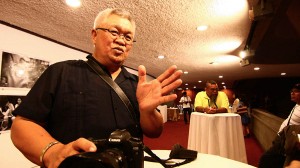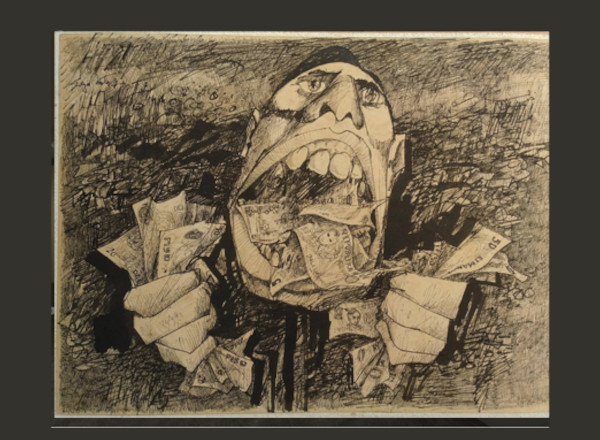Text by ARTHA KIRA PAREDES
Photos and Video by VINCENT GO
RODALLIE Mosende was a homeless girl who appeared destined to be one of many poor people prowling the streets of Quiapo. That is, until documentary photographer Rick Rocamora chanced upon her and took her picture.
That picture, which showed Rodallie standing beside a small stall festooned with the rest of what her family possessed, captured the attention of viewers who then sent money for her education. Now, she has the opportunity to finish college and face a much better future.
It is positive outcomes such as this that make Rocamora say “I have to make a stand on issues…that’s how I work and that’s who I am.”
For two-and-a-half decades now, 65-year-old Rocamora has become the visual voice of his subjects. Challenging the tenets of impartiality and objectivity that photojournalists are supposed to adhere to, he calls himself a “walking social service agency” for his subjects, to the point that he even cooks for them and brings them to the doctor when they are sick.
Rocamora talked at length about his work at the opening on June 13 of With Passion and Purpose, an exhibit of his pictures at the second floor Hallway Gallery of Cultural Center of the Philippines’ Main Theater Building. The exhibit runs until August 12.
Rocamora’s subjects have included inmates facing harsh living conditions in jails, Muslims experiencing discrimination after the 9/11 attack, and elderly Filipino World War II veterans based in the U.S.
Photography for anger management
Rocamora says he decides on which subjects to pursue based mostly on what angers him because “that’s the one that forces me to do the work, immaterial, (ir)regardless whether I have funding or not so most of these works started without funding.”
Of the two types of documentary photographers—one who documents to get grants, recognition, projects and exhibitions for himself and another whose work represents his subjects and helps his subjects along the way—he says that he is the latter.
Chris Millado, CCP Vice President and Artistic Director described Rocamora’s work saying “what is sophisticated about the images, is the eye, the photographer’s eye.”
“I suspect that he might not even be using the most expensive cameras but the most expensive use of timing and the most expensive use of imagination so much so that what you see in the walls actually jump out to us as if these single frames tell us, (are) living with stories,” Millado added.
Late bloomer
While some discover their inclination for photography at an early age, Rocamora who was born on February 18, 1947, discovered his at age 40 while at the peak of his career in the pharmaceutical industry in the U.S. where he had then been based for close to 20 years.
“I was doing good but it (was) not meaningful anymore,” he said of his jetsetting life then which meant travelling between four to eight months a year.
Although the job paid well, he said he was getting tired of meeting goals in sales year after year. During that time, he met Maryknoll priest Ed Gerlock, who had been deported from the Philippines. Gerlock stayed with his family in California and bought Rocamora his first camera from Hong Kong.
His newfound fascination with photography prompted Rocamora to decide to leave the corporate world and be a freelance photographer.
As Rocamora made a midlife career shift, he said he was aware he would be earning less but at the same time able to concentrate on issues that would eventually constitute his advocacies.
Close and personal relations
And so photography became Rocamora’s way of raising issues he was concerned about and telling stories of individuals and groups, with his camera as his tool.
And because he had a marketing background, he was able to sell his stories to a wider audience, he said.
Rocamora’s work on display also includes the documentation of Filipino U.S. veterans for close to two decades. His photographs appear in his photobook America’s Second-Class Veterans published in 2009.
Among Rocamora’s subjects was the late Magdaleno Duenas, who was one of hundreds of Filipino soldiers who fought for the U.S. in World War II but were no longer entitled to a veteran’s benefit.
Duenas had lived in squalid conditions in San Francisco and was one of the many haunting stories of veterans who had been allowed to enter and live in the U.S, but deprived of the benefits of World War II veterans.
Rocamora retells the story of Duenas being fed dog food and chained to a bed post by Catalino Dazo who pretended to be an immigration lawyer to gain the trust of 10 veterans then maltreated them for over a year. Rocamora made it a point to visit Duenas, bring him food or take him to the doctor when needed.
“This body of work will serve as a reminder to the next generation of Filipinos and Filipino-Americans, that America had not been fair to our heroes,” he said.
More stories to tell
Since 1988, Rocamora has mounted solo shows and been part of group exhibits in California, New York, California and Arizona and countries such as Italy, Japan and the Philippines.
He was also named Visual Fellow of the California Arts Council, New California Media Photographer of the Year and won first place at the Asian American Journalist Association National Awards for his photo essay CAGED: Manila’s Invisible Children.
Rocamora said the strong influences on his work are W. Eugene Smith and Gordon Parks “partly because they end up helping their subjects.” Incidentally, Park’s profile also says that, like Rocamora, he is a self-taught photographer.
Among the advocacies he has taken up lately is responsible mining, after he was commissioned by a mining company in Rio Tuba, Palawan. “I’ve proven to myself that this group that I work in Rio Tuba is probably a model company for everyone to emulate,” he said.
As a way of giving back to the craft, he has made it a quest to mentor promising photographers. He usually selects those that show “potential and consistency” and “real concern for their subjects and not about themselves.”
He is also set to give an Artist Talk on June 21 at 2:00 to 5:00 p.m. and a Lecture on Documentary Photography on June 23 from 10:00 a.m. to 12:00 noon.

